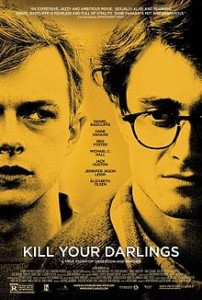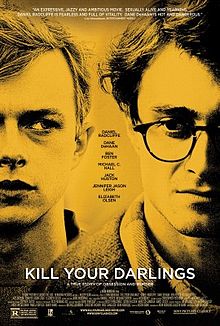 To date, I have avoided discussing the much publicised independent film Kill Your Darlings on 17th Street. Starring Daniel Radcliffe, Dane DeHann, and Michael C. Hall, the film claims to document the “true story” of the founding of the Beat Generation and focuses on “the murder that united the Beats,” 1944 murder of David Kammerer by Lucien Carr (Caleb Carr’s father). As none of the Carr family were consulted by the film’s research team and nobody from the family commented on the film following its release, I had made the decision to avoid discussing the film on the 17th Street blog, which I have always endeavored to keep strictly dedicated to Caleb Carr’s professional work and interviews. However, with the release of the film on DVD in a few weeks, Mr. Carr has recently spoken out about the film’s version of events, describing it as a “terribly inaccurate reading … based almost entirely on Allen Ginsberg’s versions of events.”
To date, I have avoided discussing the much publicised independent film Kill Your Darlings on 17th Street. Starring Daniel Radcliffe, Dane DeHann, and Michael C. Hall, the film claims to document the “true story” of the founding of the Beat Generation and focuses on “the murder that united the Beats,” 1944 murder of David Kammerer by Lucien Carr (Caleb Carr’s father). As none of the Carr family were consulted by the film’s research team and nobody from the family commented on the film following its release, I had made the decision to avoid discussing the film on the 17th Street blog, which I have always endeavored to keep strictly dedicated to Caleb Carr’s professional work and interviews. However, with the release of the film on DVD in a few weeks, Mr. Carr has recently spoken out about the film’s version of events, describing it as a “terribly inaccurate reading … based almost entirely on Allen Ginsberg’s versions of events.”
Rather than paraphrase Mr. Carr’s full statement here, I have included the first two paragraphs of the statement below and provide a link to its original source for visitors to continue reading.
You’re wholly right that “Kill Your Darlings” was a tired, ludicrous reading of the story of the murder case; and like all the other terribly inaccurate readings that have been put out there, it was based almost entirely on Allen Ginsberg’s versions of events. And Allen had an awful lot of reasons for revising the facts to suit a narrative that served his ego and his agenda far more effectively than it did the truth.
First off, the facts of the case: David Kammerer did not begin his obsession, as you have rightly suspected, when my father was an adult: it began when my father was only twelve or so, and Kammerer was his Boy Scout troop leader (and the fact that my father later killed Kammerer with his Boy Scout knife is not something that any psychologist or detective I know would ever dare to call a coincidence).
The remainder of the statement contains a powerful message about the damage produced by child abuse, the impact it has across generations, and the film’s distortion of the murder it supposedly documented. I, for one, am grateful that Mr. Carr has spoken out, and I hope that other visitors of 17th Street will feel similarly.

